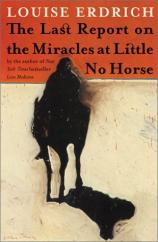The Last Report on the Miracles at Little No Horse
Review
The Last Report on the Miracles at Little No Horse
In THE LAST REPORT ON THE MIRACLES AT LITTLE NO HORSE, Louise Erdrich proves once again that she is a masterful storyteller. The author of the National Book Critics Circle Award-winning novel LOVE MEDICINE returns to the fictional North Dakota Ojibwe reservation of Little No Horse and its vigorous, flawed, sometimes supernaturally gifted residents Lulu Lamartine, Nanapush, and Fleur Pillager.
The narrative is framed by a Vatican-initiated inquiry into the possible sainthood of Sister Leopolda. The star witness in the inquiry, and central character of this story, is the missionary priest who remembers her all too clearly: Father Damien…formerly Agnes DeWitt…formerly Sister Cecelia. In the very first pages of the novel, we are introduced to the kindly, elderly Father Damien and the secret of his gender. Father Damien arrived at the Little No Horse reservation under false but well-intentioned pretenses and carried out the work of the church by converting inhabitants to Catholicism. By turn he questioned their spiritual philosophy, forgave their trespasses and, finally, took to his heart the Anishinaabeg's way of life.
Erdrich knowledgeably and compassionately conveys the desperation of life on the reservation: the alcoholism, poverty, and exodus of its youth. At the same time, we soon see past the descriptions of the poor meals eaten and the horrific North Dakota winters endured and become caught up in the trials and triumphs of their lives --- which are always, in Erdrich's novels, the triumphs and tribulations of human spirits everywhere --- and forget the dramatic difference between that environment and ours. Having grown up in the same region as Erdrich, the Red River Valley of Minnesota, I recognize the landscape: the frozen fields, the black skeletal oak trees of winter, the humble wild rice stands on the edges of small reservation towns. But as a reader, the vivid landscape recedes to the fringes of one's vision while the exploits of Sister Leopolda and Fleur Pillager take center stage. This is part of Erdrich's gift: to portray in an exacting, impressive way a landscape that is alien to most in such a way that it begins to feel natural to us and, finally, to become secondary to the universal human experiences that take place there.
Father Damien's presence on the reservation brings into focus the white man's forced and forceful role in reservation society. The strict rules of Catholicism do not mesh easily with Native American spirituality. At times, the two could not seem more different. But Father Damien's mission becomes transmuted by his ongoing interaction with the Ojibwe and he occasionally questions --- in his conversations with the wise and wily Nanapush --- whether his goal of conversion is indeed the right thing. When Father Damien attempts to resolve the personal and religious issues that trouble him most by writing letters to the Pope in Rome, mailing them off in faith and receiving no response, he cannot help but admit the reality, the tangibility of the Native American spirituality before him, in the earth, in the rocks and trees. Life inside the rectory and the convent, shown from 1920 to 1996 in this novel, is a world of courageous perseverance in the face of doubt and compassion for all, despite petty interior squabbles.
Father Damien's goal on the reservation shifts during his 75-year tenure, from baptizing as many Native Americans as possible to bestowing forgiveness on every confessor he comes across. Forgiveness is a spiritual need Father Damien finds, as he contends with his own mortal sins. Seeing that everyone from the most devout parishioner to the most pagan resident has human failings, Father Damien realizes that neither gender nor religious denomination dictate the make-up of the soul, and he sets about righting the crippling burdens of guilt that crush those around him.
One of the most fruitful friendships he has on the reservation, in fact, is with the blissfully pagan and deliciously sly Nanapush. Nanapush debates with Father Damien matters of the spirit, shares funny stories and Native American myths and, most importantly, lives a life of truth rather than piety. In a game of chess with Nanapush one day, Father Damien is paralyzed with fear when Nanapush indicates that he knows the secret of Father Damien's identity…but in a reverse turn beautifully executed by Erdrich, Father Damien realizes through his tears that Nanapush has only used the revelation to distract him from the chess game. Nanapush accepts Father Damien's spirit regardless of what is underneath his cassock. Faced with this instinctive humanitarian response, Father Damien is flabbergasted and inspired.
The threads of this story's beautiful, complex tapestry are strengthened by humanity and colored by humor. Myths and anecdotes such as the tragically hilarious incident involving undercooked beans, moose droppings, and the love of a tough woman, all of which result in Nanapush's death, are thankfully the norm with Erdrich. Long live Nanapush!
Reviewed by Stephanie Sorensen on January 22, 2011
The Last Report on the Miracles at Little No Horse
- Publication Date: April 1, 2001
- Genres: Fiction
- Hardcover: 368 pages
- Publisher: HarperCollins
- ISBN-10: 0060187271
- ISBN-13: 9780060187279










